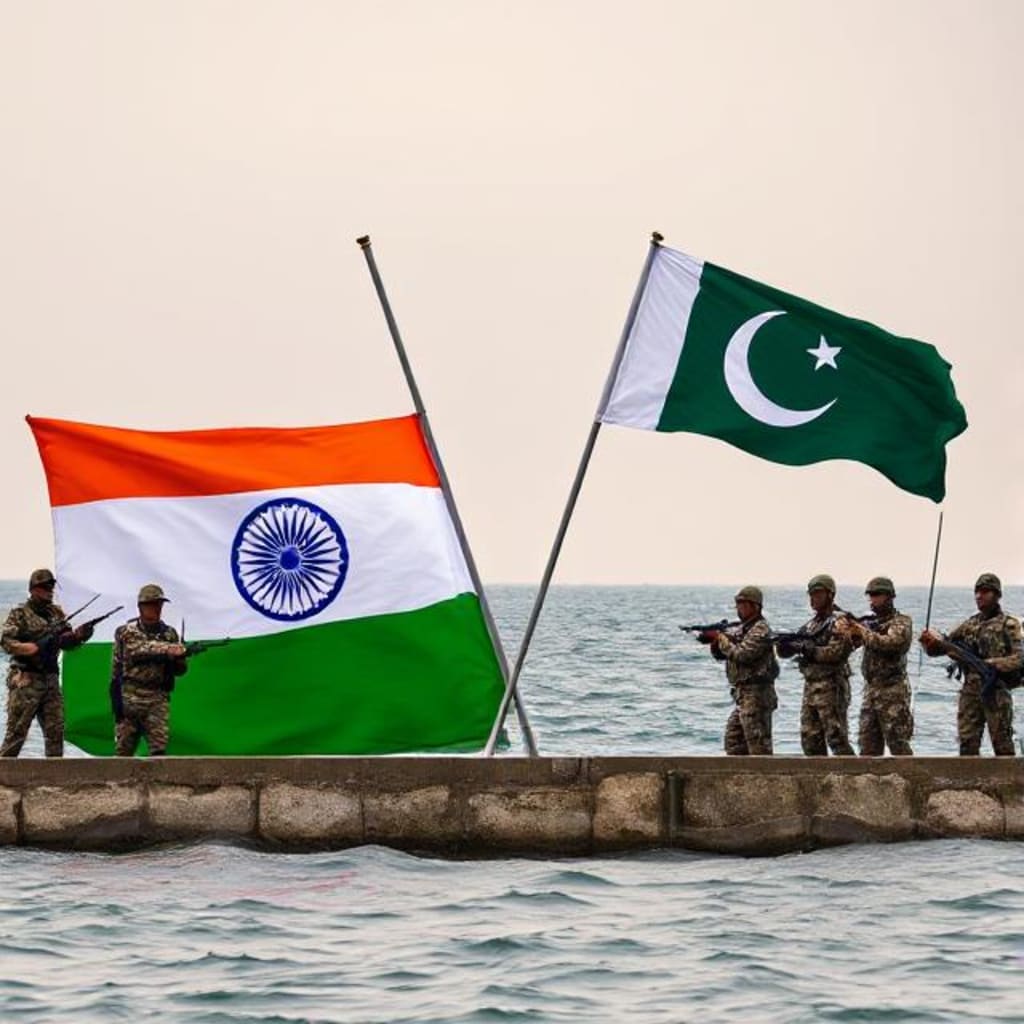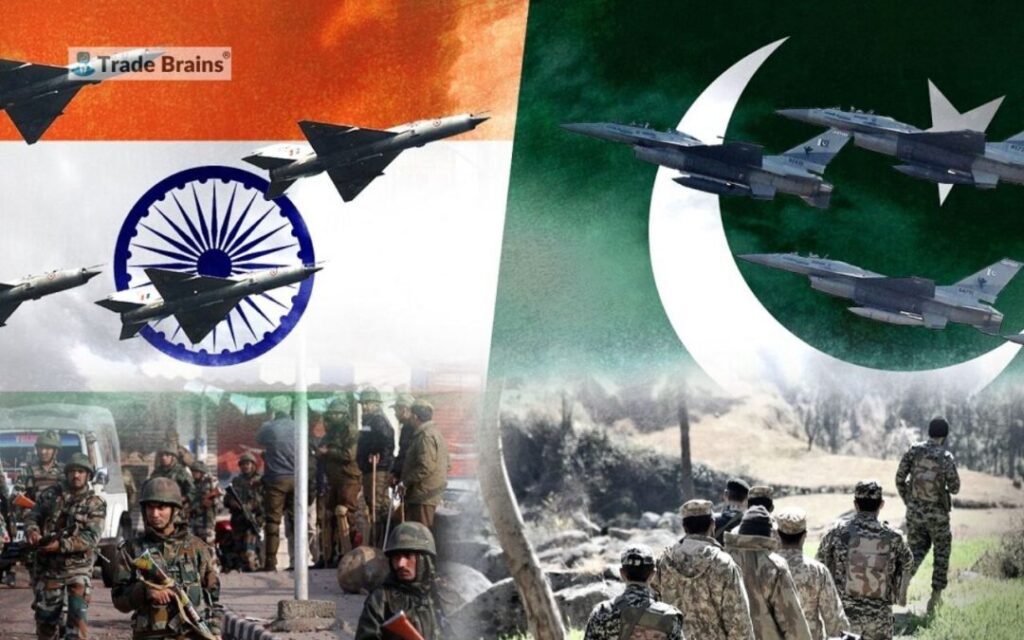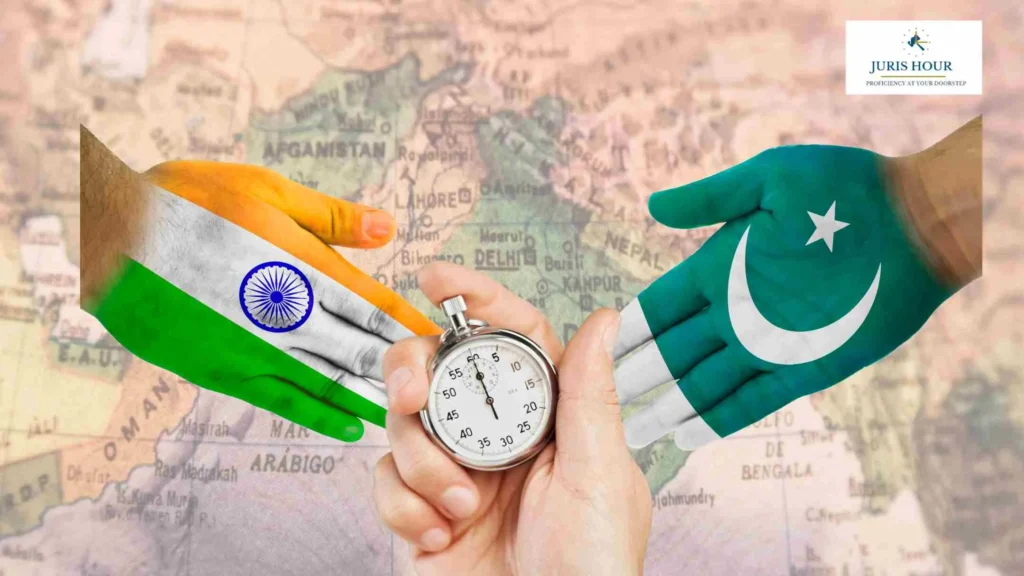Introduction

The India-Pakistan relationship is one of the most enduring and volatile rivalries in modern geopolitics.India vs Pakistan War 2025.Rooted in the 1947 partition, the conflict has since been shaped by war, diplomacy, ideology, and deeply entrenched historical grievances—most notably centered around the Kashmir region. By 2025, both nations have undergone significant military modernization, while continuing to grapple with internal and external challenges.India vs Pakistan War 2025
A hypothetical war between India and Pakistan in 2025 would not only threaten regional security but could also spiral into a catastrophic global conflict due to the presence of nuclear weapons. This essay explores the background, potential causes, execution, and consequences of such a conflict. Through critical analysis, it emphasizes the necessity of diplomatic engagement over armed confrontation.India vs Pakistan War 2025
Historical Context
India and Pakistan have fought four major wars since their independence: in 1947–48, 1965, 1971, and the Kargil War in 1999. Each of these conflicts was shaped by the unresolved status of Kashmir, ideological divergence, and competing national identities.
The 1947-48 war resulted in the division of Kashmir into Indian-administered and Pakistani-administered areas. The 1965 war further entrenched hostilities but ended in a stalemate, with a UN-mediated ceasefire. In 1971, war broke out over East Pakistan, culminating in the creation of Bangladesh—a significant blow to Pakistan’s geopolitical standing. The 1999 Kargil conflict, triggered by Pakistani incursions into Indian territory, highlighted the potential for war even under nuclear deterrence.India vs Pakistan War 2025
Since 2000, both nations have engaged in frequent border skirmishes, especially along the Line of Control (LoC). The 2008 Mumbai attacks and the 2016 Uri attack, followed by India’s surgical strikes and the 2019 Balakot airstrike after the Pulwama bombing, underscore how acts of terrorism have become flashpoints for military responses.
Despite multiple ceasefire agreements, trust remains elusive. The revocation of Article 370 in 2019 by India, which removed Jammu and Kashmir’s special status, further exacerbated tensions. While both countries possess significant conventional and nuclear capabilities, diplomacy has repeatedly failed to produce a lasting peace.India vs Pakistan War 2025
Geopolitical Landscape in 2025
As of 2025, India has emerged as one of the world’s leading economies with a rapidly modernizing military. Its strategic focus is on self-reliance in defense production, cyber warfare capability, and space-based surveillance. The Indian Armed Forces have expanded joint operations and logistics with global partners including the United States, France, and Japan.
Pakistan, while facing economic and political challenges, continues to maintain a credible deterrent posture. With deep ties to China and growing cooperation with Russia and Turkey, Islamabad remains strategically important in the region. Pakistan’s military continues to exert considerable influence on its civilian leadership.India vs Pakistan War 2025
China’s growing assertiveness in South Asia and its border clashes with India have brought Beijing and Islamabad closer. The China-Pakistan Economic Corridor (CPEC) is a cornerstone of this alliance, often viewed with suspicion by New Delhi.
Meanwhile, global powers—especially the U.S. and Russia—seek stability in the region. The United States, increasingly concerned with containing China, balances its relationships with both India and Pakistan. Russia, traditionally an ally of India, is now trying to expand ties with Islamabad. The role of non-state actors, especially in Pakistan-occupied Kashmir (PoK), adds further complexity to an already unstable situation.India vs Pakistan War 2025
Causes of the Hypothetical War
In this scenario, war is triggered by a high-profile terrorist attack on a major Indian city in early 2025, attributed to Jaish-e-Mohammed (JeM), a group allegedly operating from PoK. Despite Pakistan’s denial of involvement, India’s intelligence community presents satellite and cyber evidence of cross-border planning.
Public pressure in India, amplified by media and political rhetoric, demands retaliation. With general elections looming, the Indian government authorizes air and cyber strikes against suspected terrorist camps across the LoC. Pakistan responds with retaliatory missile strikes on Indian military installations, and the situation escalates rapidly.India vs Pakistan War 2025
Several miscalculations contribute to the conflict:
- Failure of backchannel diplomacy
- Underestimation of the enemy’s military response
- Overconfidence in limited warfare doctrine
- Escalation by non-state actors operating outside government control
Social media adds fuel to the fire, spreading misinformation and nationalist fervor on both sides. Meanwhile, global leaders call for restraint, but diplomatic efforts are too slow to prevent a full-scale conflict.India vs Pakistan War 2025
Course of the War: A Hypothetical Scenario

The war begins with precision airstrikes by the Indian Air Force targeting camps and command centers in PoK. India also launches cyber operations to disable key communication networks in northern Pakistan. Pakistan retaliates with drone swarms and missile strikes on Indian border posts and military airports.India vs Pakistan War 2025
Naval skirmishes erupt in the Arabian Sea, with Indian and Pakistani submarines shadowing each other aggressively. As the conflict intensifies, both sides mobilize troops near the LoC and the Punjab border. India launches Operation Trident—a coordinated air-land assault in select sectors of Kashmir. Pakistan counters with Operation Zarb-e-Haq, focusing on high-altitude defenses and guerrilla-style operations.
In a dramatic turn, Pakistani forces deploy tactical nuclear weapons near the border, not for immediate use but as a deterrent. This move alarms the international community. India, in response, places its strategic forces on high alert, activating its nuclear triad.India vs Pakistan War 2025
As casualties mount and infrastructure is damaged on both sides, international pressure becomes overwhelming. China issues a warning against nuclear escalation, while the United States and Russia jointly broker an emergency UN Security Council meeting. Under global pressure and looming economic collapse, both sides agree to a ceasefire.
The war lasts for three weeks, claiming tens of thousands of lives. Cities like Lahore, Amritsar, Srinagar, and Rawalpindi suffer extensive damage. The psychological trauma is immense, with millions displaced.India vs Pakistan War 2025
Consequences and Aftermath
The consequences of this short but intense war are devastating. Economically, both countries suffer immense losses. Stock markets crash, foreign investments evaporate, and inflation skyrockets. India’s urban centers face power blackouts due to cyber attacks. Pakistan’s energy infrastructure is crippled.India vs Pakistan War 2025
Humanitarian agencies report a massive refugee crisis along the LoC. Thousands flee Kashmir, and refugee camps become overcrowded and disease-ridden. Human rights organizations report war crimes and civilian casualties, further staining the reputations of both nations.
Diplomatically, both India and Pakistan face scrutiny. Pakistan is accused of harboring terror outfits, while India is criticized for disproportionate retaliation. The United Nations imposes arms embargoes and initiates a South Asia Peacekeeping Mission.
Internally, political upheaval follows. Indian and Pakistani governments face massive protests demanding accountability. Military officials are forced to resign. Nationalistic media narratives begin to lose credibility as the harsh realities of war become clear.India vs Pakistan War 2025
In the aftermath, both nations are forced into dialogue under international supervision. A new peace process is initiated, with a focus on nuclear de-escalation, intelligence cooperation, and revisiting the Kashmir issue under humanitarian principles.
Conclusion
A war between India and Pakistan in 2025, though hypothetical, underscores the fragile nature of South Asian peace. While military strategies and deterrents exist, they are often undermined by political compulsions, public pressure, and the unpredictable behavior of non-state actors.India vs Pakistan War 2025
There are no real winners in such a conflict. The loss of lives, economic devastation, and regional instability only highlight the futility of war. The only sustainable path forward lies in diplomacy, mutual trust-building, and regional cooperation. As history shows, peace is harder to achieve—but infinitely more valuable—than war.
Would you like a formatted PDF version or citations added for academic use?
Introduction
The India-Pakistan relationship remains one of the most complex and potentially explosive in global geopolitics. Marked by deep historical grievances, unresolved territorial disputes, and nationalistic fervor on both sides, the hostility has been sustained over decades, with Kashmir at its epicenter. As nuclear-armed neighbors, India and Pakistan have walked the tightrope of deterrence since both became overt nuclear powers in the late 1990s.
In 2025, the geopolitical environment is characterized by increasing multipolar tensions, digital propaganda, and volatile domestic politics in both countries. A hypothetical war between these two South Asian giants—while not inevitable—is entirely plausible under the right (or wrong) set of circumstances. This essay explores such a scenario: how it might be triggered, how it could unfold, and what the regional and global consequences would be. Ultimately, it underscores the urgent need for diplomacy, restraint, and structural reform in bilateral relations.India vs Pakistan War 2025
Historical Context
India and Pakistan were born out of the violent partition of British India in 1947. The wounds of partition, which led to the displacement of over 10 million people and the deaths of hundreds of thousands, laid the foundation for enmity. The first war in 1947–48 was sparked by tribal militias from Pakistan invading Kashmir, a princely state that had acceded to India. This war resulted in the division of Kashmir, but without a final resolution.India vs Pakistan War 2025
Subsequent wars in 1965 and 1971 escalated the conflict, with the latter resulting in the secession of East Pakistan and the creation of Bangladesh. In 1999, the Kargil conflict marked the first confrontation between two declared nuclear powers. The war was confined to a limited area but underscored the fragility of deterrence.
In the years since, the countries have experienced several military standoffs and skirmishes. Events such as the 2001 Indian Parliament attack, the 2008 Mumbai terror attacks, and the 2016 Uri attack followed by India’s “surgical strikes” reflect a pattern of provocation and response. In 2019, the Pulwama bombing and the retaliatory Balakot airstrikes nearly brought the two countries to the brink of full-scale war.India vs Pakistan War 2025
The revocation of Article 370 by India in 2019 further deepened mistrust. Although the LoC has seen intermittent ceasefires, the risk of conflict remains ever-present due to the unresolved Kashmir dispute, cross-border terrorism, and domestic political pressures.
Geopolitical Landscape in 2025
By 2025, India has solidified its position as a major global player, both economically and militarily. Under successive governments focused on military modernization, India has acquired state-of-the-art equipment such as fifth-generation fighter jets, hypersonic missiles, cyber weapons, and AI-powered surveillance systems. Its partnership with the United States has grown stronger under the Indo-Pacific framework.India vs Pakistan War 2025
Pakistan, while economically strained, continues to prioritize its military strength, particularly with the aid of China. It has invested in drone warfare, short-range ballistic missiles, and cyber defense. Though not as technologically advanced as India, Pakistan compensates through asymmetric warfare capabilities and intelligence networks.
China’s strategic partnership with Pakistan through the Belt and Road Initiative (specifically CPEC) gives Islamabad additional geopolitical leverage. Meanwhile, India is seen as a counterweight to China in the Indo-Pacific, aligning with Japan, Australia, and the U.S. in the Quad alliance.India vs Pakistan War 2025
Russia plays a more balanced role in 2025, selling arms to both countries. The Gulf States, particularly the UAE and Saudi Arabia, have growing influence in Islamabad and seek stability for economic reasons. The Taliban-controlled Afghanistan remains a wildcard, serving as a potential staging ground for non-state actors and proxy conflicts.
Causes of the Hypothetical 2025 War
In this hypothetical scenario, the immediate trigger is a coordinated terrorist attack on an Indian software technology park in Bangalore, killing over 200 civilians, including foreign nationals. The attackers are traced back to Pakistan-based groups with alleged ties to its intelligence services. Despite Islamabad’s denial of involvement, India presents satellite and cyber-traced evidence of direct planning support from handlers in PoK.India vs Pakistan War 2025
Facing mounting public pressure, the Indian government—already under fire for its handling of border issues with China—decides to respond militarily. Nationalist rhetoric dominates media outlets, and political parties compete in demonstrating toughness.India vs Pakistan War 2025

Pakistan’s response is similarly defiant. Its leadership warns of dire consequences for any violation of its sovereignty. Domestic protests rally around anti-India sentiment, and religious clerics call for “defense of Islam and Kashmir.”
Diplomatic channels falter. Track-II dialogues collapse amid threats and provocations. Media on both sides fuel hysteria, and social media becomes a breeding ground for misinformation and hate speech. As troop buildups begin near the LoC and Rajasthan border, the world watches with growing alarm.
Course of the War: Hypothetical Military and Technological Escalation
Phase 1: Opening Salvo
India launches “Operation Iron Fist,” targeting terrorist camps and communication hubs in PoK using drones, cyberattacks, and precision airstrikes. These attacks cause significant damage and are publicized with satellite imagery. Pakistan retaliates with cross-border artillery strikes and aerial skirmishes.India vs Pakistan War 2025
Phase 2: Escalation
Cyber warfare enters center stage. Indian railway networks and financial systems suffer temporary shutdowns from malware attacks traced to Pakistani cyber units. India responds by jamming Pakistani satellite communications and targeting power grids in Sindh.
Missile exchanges intensify. India deploys BrahMos cruise missiles while Pakistan fires short-range Nasr missiles on Indian military outposts. Civilian casualties rise as both sides begin striking infrastructure and logistics hubs.
Phase 3: Naval Confrontation and International Reaction
The Indian Navy blockades Karachi port, leading to fuel and food shortages in urban Pakistan. Submarine warfare escalates in the Arabian Sea. U.S. and Russian warships patrol international waters to prevent a spillover into international trade routes.
The UN calls for immediate de-escalation. China warns against Indian aggression, while the U.S. calls out Pakistan for harboring terror groups. The G20 convenes emergency talks, and the Vatican calls for a humanitarian ceasefire.
Phase 4: Brink of Nuclear Exchange
Pakistan moves tactical nuclear weapons to the Punjab border. India places its Agni-V ICBMs on standby. Global panic ensues. Media leaks suggest contingency plans for nuclear evacuation in major Indian and Pakistani cities.
Fortunately, through backchannel communication involving the UAE, Turkey, and Switzerland, a ceasefire is negotiated just as both nations prepare for a possible limited nuclear strike.
Consequences and Aftermath
Human Cost:
Over 80,000 people are killed in three weeks, with millions displaced. Entire towns in Kashmir, Punjab, and Sindh are reduced to rubble. Medical infrastructure collapses. Schools and places of worship are turned into refugee camps. The psychological toll, especially on children, is immense.India vs Pakistan War 2025
Economic Impact:
Both nations face recessions. The Indian economy, though larger, loses $200 billion in direct losses. Pakistan’s economy contracts by 12%. The rupee and the Pakistani rupee plummet. Stock exchanges in Mumbai and Karachi shut down for days. Foreign investors withdraw en masse.
Diplomatic Fallout:
Pakistan faces renewed scrutiny from the FATF and is further isolated. India faces criticism for disproportionate strikes but earns global sympathy for its victims. Both countries face sanctions. The BRICS summit is postponed, and the SAARC becomes effectively defunct.
Technological Implications:
The war becomes a case study in hybrid warfare. Cyber attacks, drone swarms, and misinformation campaigns redefine how wars are fought in the 21st century. Tech companies are criticized for allowing war propaganda to spread unchecked.
Civil Society and Protests:
Postwar, both countries witness a wave of anti-war protests. Civil rights groups demand peace, transparency, and a reevaluation of nuclear doctrines. There’s growing demand in both countries for demilitarizing the Kashmir region and investing in healthcare and education instead.India vs Pakistan War 2025
Toward a New Peace Process
Following the war, a new South Asia Peace Accord (SAPA) is proposed by the United Nations. It calls for:
- Establishing a demilitarized buffer zone in Kashmir under UN supervision
- Resuming bilateral dialogue on trade, water-sharing, and border demarcation
- Creating a joint Indo-Pakistani anti-terrorism intelligence task force
- Launching truth and reconciliation commissions for victims on both sidesIndia vs Pakistan War 2025
Educational exchanges, sports diplomacy (resumption of cricket tours), and interfaith dialogue are encouraged to rebuild people-to-people connections. The global community, including China and the U.S., pledges to fund reconstruction and rehabilitation in the affected areas.
Conclusion
The hypothetical India-Pakistan war of 2025, while fictional in this essay, reflects very real risks and dynamics in South Asia today. With nuclear weapons in play and fragile political systems under pressure, even minor provocations can trigger major conflicts. The lessons from this imagined war are clear: war, especially between two nuclear states, is no longer a viable instrument of policy.India vs Pakistan War 2025
Only through sustained diplomacy, mutual respect, and cooperation can these two nations hope to break the cycle of violence. Both countries must choose dialogue over dogma, peace over pride, and shared prosperity over perpetual hostility. The future of over 1.5 billion people depends on it.India vs Pakistan War 2025
Would you like a title page, references, or formatting suitable for academic submission (APA/MLA)?
https://shorturl.fm/CoP7o
https://shorturl.fm/Xv8Za
https://shorturl.fm/iK291